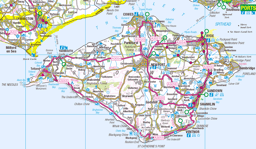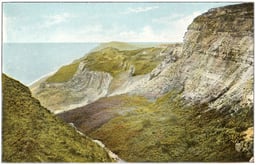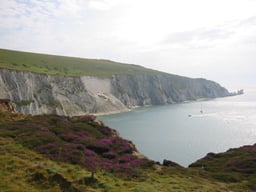Isle of Wight
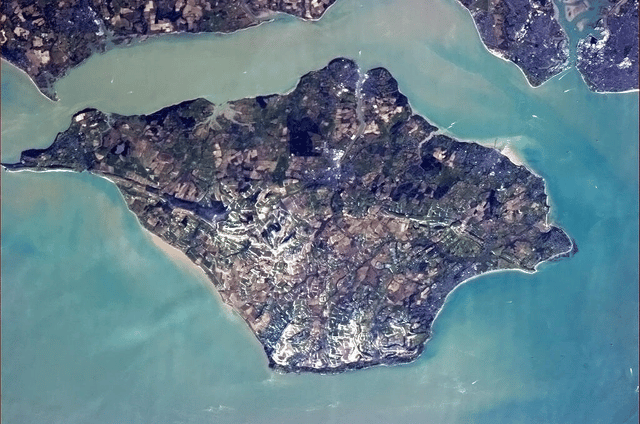
Isle of Wight

| Isle of Wight | |||
|---|---|---|---|
| County | |||
| |||
| Motto: "All this beauty is of God" | |||
 | |||
| Coordinates:50°40′N 1°16′W [158] | |||
| Sovereign state | United Kingdom | ||
| Constituent country | England | ||
| Region | South East | ||
| Established | 1890 | ||
| Preceded by | Hampshire | ||
| Ceremonial county | |||
| Lord Lieutenant | Susan Sheldon[3] | ||
| High Sheriff | Geoffrey Underwood[4] (2019/20) | ||
| Area | 384 km2(148 sq mi) | ||
| • Ranked | 46th of 48 | ||
| Population (mid-2018 est.) | 141,000 | ||
| • Ranked | 46th of 48 | ||
| Density | 370/km2(960/sq mi) | ||
| Ethnicity | 97.3% White, 1.1% Asian, 0.2% Black, 0.1% Other, 1.2% Mixed[5] | ||
| Unitary authority | |||
| Council | Isle of Wight Council | ||
| Executive | Conservative | ||
| Admin HQ | Newport | ||
| Area | 380.2 km2(146.8 sq mi) | ||
| • Ranked | 103rd of 326 | ||
| Population | 141,538 | ||
| • Ranked | 153rd of 326 | ||
| Density | 370/km2(960/sq mi) | ||
| ISO 3166-2 | GB-IOW | ||
| ONS code | 00MW | ||
| GSS code | E06000046 | ||
| NUTS | UKJ34 | ||
| Member of Parliament | Bob Seely | ||
| Police | Hampshire Constabulary | ||
| Time zone | Greenwich Mean Time (UTC) | ||
| • Summer (DST) | British Summer Time (UTC+1) | ||
The Isle of Wight (/waɪt/; also referred to informally as The Island or abbreviated to IoW)[6] is a county and the largest and second-most populous island in England. It is in the English Channel, between 2 and 5 miles off the coast of Hampshire, separated by the Solent. The island has resorts that have been holiday destinations since Victorian times, and is known for its mild climate, coastal scenery, and verdant landscape of fields, downland and chines. The island is designated a UNESCO Biosphere Reserve.
The island has been home to the poets Swinburne and Tennyson and to Queen Victoria, who built her much-loved summer residence and final home Osborne House at East Cowes. It has a maritime and industrial tradition including boat-building, sail-making, the manufacture of flying boats, the hovercraft, and Britain's space rockets. The island hosts annual music festivals including the Isle of Wight Festival, which in 1970 was the largest rock music event ever held.[7] It has well-conserved wildlife and some of the richest cliffs and quarries for dinosaur fossils in Europe.
The isle was owned by a Norman family until 1293 and was earlier a kingdom in its own right.[8] In common with the Crown dependencies, the British Crown was then represented on the island by the Governor of the Isle of Wight[1] until 1995. The island has played an important part in the defence of the ports of Southampton and Portsmouth, and been near the front-line of conflicts through the ages, including the Spanish Armada and the Battle of Britain. Rural for most of its history, its Victorian fashionability and the growing affordability of holidays led to significant urban development during the late 19th and early 20th centuries. Historically part of Hampshire, the island became a separate administrative county in 1890. It continued to share the Lord Lieutenant of Hampshire until 1974, when it was made its own ceremonial county. Apart from a shared police force, and the island's Anglican churches belonging to the Diocese of Portsmouth (originally Winchester), there is now no administrative link with Hampshire; although a combined local authority with Portsmouth and Southampton was considered,[9] this is now unlikely to proceed.[10]
The quickest public transport link to the mainland is the hovercraft from Ryde to Southsea; three vehicle ferry and two catamaran services cross the Solent to Southampton, Lymington and Portsmouth.
| Isle of Wight | |||
|---|---|---|---|
| County | |||
| |||
| Motto: "All this beauty is of God" | |||
 | |||
| Coordinates:50°40′N 1°16′W [158] | |||
| Sovereign state | United Kingdom | ||
| Constituent country | England | ||
| Region | South East | ||
| Established | 1890 | ||
| Preceded by | Hampshire | ||
| Ceremonial county | |||
| Lord Lieutenant | Susan Sheldon[3] | ||
| High Sheriff | Geoffrey Underwood[4] (2019/20) | ||
| Area | 384 km2(148 sq mi) | ||
| • Ranked | 46th of 48 | ||
| Population (mid-2018 est.) | 141,000 | ||
| • Ranked | 46th of 48 | ||
| Density | 370/km2(960/sq mi) | ||
| Ethnicity | 97.3% White, 1.1% Asian, 0.2% Black, 0.1% Other, 1.2% Mixed[5] | ||
| Unitary authority | |||
| Council | Isle of Wight Council | ||
| Executive | Conservative | ||
| Admin HQ | Newport | ||
| Area | 380.2 km2(146.8 sq mi) | ||
| • Ranked | 103rd of 326 | ||
| Population | 141,538 | ||
| • Ranked | 153rd of 326 | ||
| Density | 370/km2(960/sq mi) | ||
| ISO 3166-2 | GB-IOW | ||
| ONS code | 00MW | ||
| GSS code | E06000046 | ||
| NUTS | UKJ34 | ||
| Member of Parliament | Bob Seely | ||
| Police | Hampshire Constabulary | ||
| Time zone | Greenwich Mean Time (UTC) | ||
| • Summer (DST) | British Summer Time (UTC+1) | ||
History
Neolithic Isle of Wight
During the last Ice Age, sea levels were lower and the Solent was part of a river flowing southeast from current day Poole Harbour towards mid-Channel of Doggerland. The Bouldner Cliff archaeological site is 1 km long, 8000 year old wooden platform at the neolithic river bank, and now submerged 12 m below sea level.[11] As sea levels rose, the river valley became flooded, and the chalk ridgeline west of the Needles breached to form the island.[12] The Isle of Wight is first mentioned in writing in Geography by Ptolemy.
Bronze and Iron Age Isle of Wight
Bronze Age Britain had large reserves of tin in the areas of Cornwall and Devon and tin is necessary to smelt bronze. At that time the sea level was much lower and carts of tin were brought across the Solent at low tide[13][14] for export, possibly on the Ferriby Boats. Anthony Snodgrass[15][16] suggests that a shortage of tin, as a part of the Bronze Age Collapse and trade disruptions in the Mediterranean around 1300 BC, forced metalworkers to seek an alternative to bronze. During Iron Age Britain, the Late Iron Age, the Isle of Wight would appear to have been occupied by the Celtic tribe, the Durotriges - as attested by finds of their coins, for example, the South Wight Hoard,[17][18] and the Shalfleet Hoard.[19] South eastern Britain experienced significant immigration that is reflected in the genetic makeup of the current residents.[20] As the Iron Age began the value of tin likely dropped sharply and this likely greatly changed the economy of the Isle of Wight. Trade however continued as evidenced by the remarkable local abundance of European Iron Age coins.[21][22]
Roman Isle of Wight
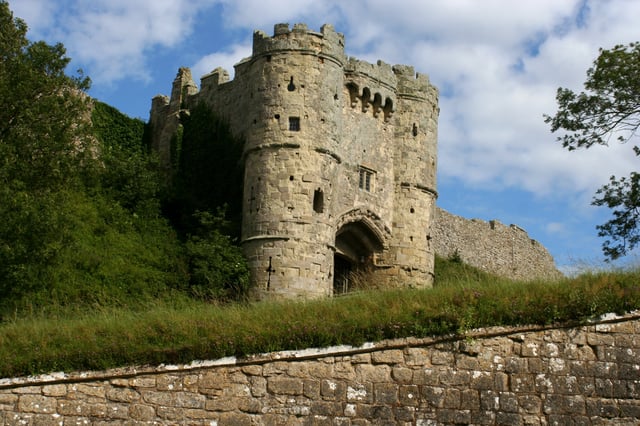
Carisbrooke Castle just outside Carisbrooke
Julius Caesar reported that the Belgae took the Isle of Wight in about 85 BC,[23] and recognised the culture of this general region as "Belgic", but made no reference to Vectis.[24] The Roman historian Suetonius mentions that the island was captured by the commander Vespasian. The Romans built no towns on the island, but the remains of at least seven Roman villas have been found, indicating the prosperity of local agriculture.[25] First-century exports were principally hides, slaves, hunting dogs, grain, cattle, silver, gold, and iron.[24] Ferriby Boats and later Blackfriars Ships likely were important to the local economy.
Early Medieval Period
Starting in AD 449 (according to the Anglo Saxon Chronicles) the 5th and 6th centuries saw groups of Germanic speaking peoples from Northern Europe crossing the English Channel and setting up home.[26] Bede's (731) Historia ecclesiastica gentis Anglorum[27] identifies three separate groups of invaders: of these, the Jutes from Denmark settled the Isle of Wight and Kent. From then onwards, there are indications that the island had wide trading links, with a port at Bouldnor,[28][29][30] evidence of Bronze Age tin trading,[14] and finds of Late Iron Age coins.[31]
During the Dark Ages the island was settled by Jutes as the pagan kingdom of Wihtwara under King Arwald. In 685 it was invaded by Caedwalla, who tried to replace the inhabitants with his own followers. In 686 Arwald was defeated and the island became the last part of English lands to be converted to Christianity,[32][33][34] added to Wessex and then becoming part of England under King Alfred the Great, included within the shire of Hampshire.
High Medieval Period
The Norman Conquest of 1066 created the position of Lord of the Isle of Wight; the island was given by William the Conqueror to his kinsman William FitzOsbern. Carisbrooke Priory and the fort of Carisbrooke Castle were then founded. Allegiance was sworn to FitzOsbern rather than the king; the Lordship was subsequently granted to the de Redvers family by Henry I, after his succession in 1100.
For nearly 200 years the island was a semi-independent feudal fiefdom, with the de Redvers family ruling from Carisbrooke. The final private owner was the Countess Isabella de Fortibus, who, on her deathbed in 1293, was persuaded to sell it to Edward I. Thereafter the island was under control of the English Crown[39] and its Lordship a royal appointment.
Late Medieval Period
The island continued to be attacked from the continent: it was raided in 1374 by the fleet of Castile,[40] and in 1377 by French raiders who burned several towns, including Newtown, and laid siege to Carisbrooke Castle before they were defeated.
Early modern period
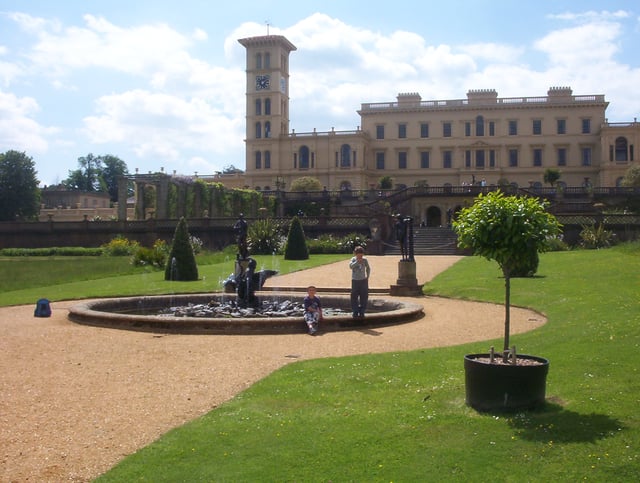
Osborne House and its grounds are now open to the public.

Eugene Manet on the Isle of Wight, 1875 painting by Berthe Morisot
Under Henry VIII, who developed the Royal Navy and its Portsmouth base, the island was fortified at Yarmouth, Cowes, East Cowes, and Sandown.
During the English Civil War, King Charles fled to the Isle of Wight, believing he would receive sympathy from the governor Robert Hammond, but Hammond imprisoned the king in Carisbrooke Castle.[42]
During the Seven Years' War, the island was used as a staging post for British troops departing on expeditions against the French coast, such as the Raid on Rochefort. During 1759, with a planned French invasion imminent, a large force of soldiers was stationed there. The French called off their invasion following the Battle of Quiberon Bay.[43]
Modern history
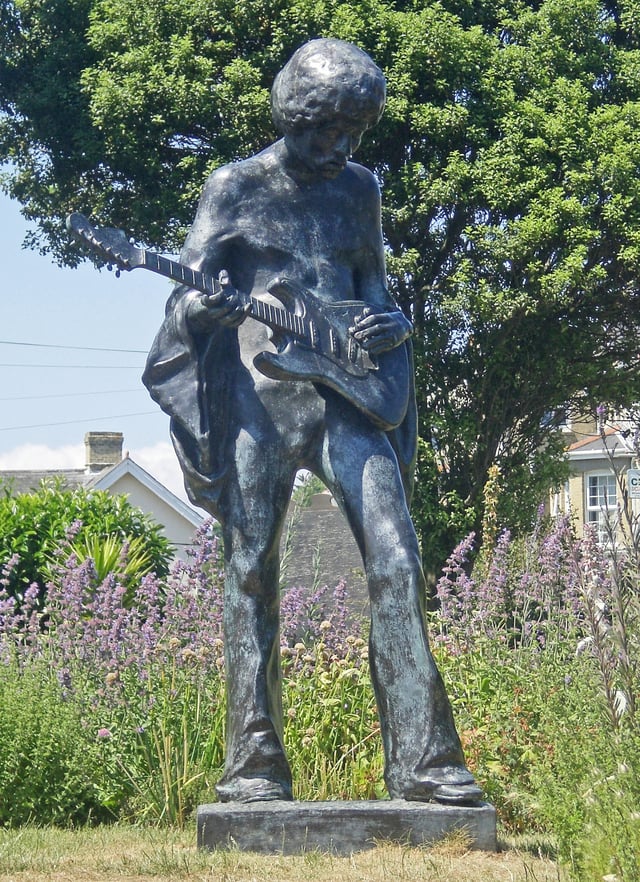
Statue of Jimi Hendrix outside Dimbola Lodge
In the 1860s, what remains in real terms the most expensive ever government spending project saw fortifications built on the island and in the Solent, as well as elsewhere along the south coast, including the Palmerston Forts, The Needles Batteries and Fort Victoria, because of fears about possible French invasion.[44]
The future Queen Victoria spent childhood holidays on the island and became fond of it. When queen she made Osborne House her winter home, and so the island became a fashionable holiday resort, including for Alfred, Lord Tennyson, Julia Margaret Cameron, and Charles Dickens (who wrote much of David Copperfield there), as well as the French painter Berthe Morisot and members of European royalty.[45] Until then, the island had been rural, with most people employed in farming, fishing or boat-building. The boom in tourism, spurred by growing wealth and leisure time, and by Victoria's example, led to significant urban development of the island's coastal resorts.
The world's first radio station was set up by Marconi in 1897, during her reign, at the Needles Battery, at the western tip of the island.[46][47] In 1898 the first paid wireless telegram (called a "Marconigram") was sent from this station, and the island was for some time[48] the home of the National Wireless Museum, near Ryde.[49]
Queen Victoria died at Osborne House on 22 January 1901, aged 81.
During the Second World War the island was frequently bombed. With its proximity to German-occupied France, the island hosted observation stations and transmitters, as well as the RAF radar station at Ventnor. It was the starting-point for one of the earlier Operation Pluto pipelines to feed fuel to Europe after the Normandy landings.[50]
The Needles Battery was used to develop and test the Black Arrow and Black Knight space rockets, which were subsequently launched from Woomera, Australia.[51]
The Isle of Wight Festival was a very large rock festival that took place near Afton Down, West Wight in 1970, following two smaller concerts in 1968 and 1969. The 1970 show was notable both as one of the last public performances by Jimi Hendrix and for the number of attendees, reaching by some estimates 600,000.[52] The festival was revived in 2002 in a different format, and is now an annual event.[53]
Etymology
The oldest records that give a name for the Isle of Wight are from the Roman Empire: it was then called Vectis or Vecta in Latin, Iktis or Ouiktis in Greek. From the Anglo-Saxon period Latin Vecta, Old English Wiht and Old Welsh forms Gueid and Guith are recorded. In Domesday Book it is Wit; the modern Welsh name is Ynys Wyth (ynys = island). These are all variant forms of the same name, possibly Celtic in origin. It may mean "place of the division", because the island divides the two arms of the Solent.[54][55][56]
Geography
The Isle of Wight is situated between the Solent and the English Channel, is roughly rhomboid in shape, and covers an area of 150 sq mi (380 km2). Slightly more than half, mainly in the west, is designated as the Isle of Wight Area of Outstanding Natural Beauty. The island has 100 sq mi (258 km2) of farmland, 20 sq mi (52 km2) of developed areas, and 57 miles (92 km) of coastline. Its landscapes are diverse, leading to its oft-quoted description as "England in miniature". In June 2019 the whole island was designated a UNESCO Biosphere Reserve, recognising the sustainable relationships between its residents and the local environment.[57]
West Wight is predominantly rural, with dramatic coastlines dominated by the chalk downland ridge, running across the whole island and ending in the Needles stacks. The southwestern quarter is commonly referred to as the Back of the Wight, and has a unique character. The highest point on the island is St Boniface Down in the south east, which at 791 feet (241 m) is a marilyn.[58] The most notable habitats on the rest of the island are probably the soft cliffs and sea ledges, which are scenic features, important for wildlife, and internationally protected.
The island has three principal rivers. The River Medina flows north into the Solent, the Eastern Yar flows roughly northeast to Bembridge Harbour, and the Western Yar flows the short distance from Freshwater Bay to a relatively large estuary at Yarmouth. Without human intervention the sea might well have split the island into three: at the west end where a bank of pebbles separates Freshwater Bay from the marshy backwaters of the Western Yar east of Freshwater, and at the east end where a thin strip of land separates Sandown Bay from the marshy Eastern Yar basin.
The Undercliff between St Catherine's Point and Bonchurch is the largest area of landslip morphology in western Europe.
The north coast is unusual in having four high tides each day, with a double high tide every twelve and a half hours. This arises because the western Solent is narrower than the eastern; the initial tide of water flowing from the west starts to ebb before the stronger flow around the south of the island returns through the eastern Solent to create a second high water.[49]
Geology
The Isle of Wight is made up of a variety of rock types dating from early Cretaceous (around 127 million years ago) to the middle of the Palaeogene (around 30 million years ago). The geological structure is dominated by a large monocline which causes a marked change in age of strata from the northern younger Tertiary beds to the older Cretaceous beds of the south. This gives rise to a dip of almost 90 degrees in the chalk beds, seen best at the Needles.
The northern half of the island is mainly composed of clays, with the southern half formed of the chalk of the central east–west downs, as well as Upper and Lower Greensands and Wealden strata.[59] These strata continue west from the island across the Solent into Dorset, forming the basin of Poole Harbour (Tertiary) and the Isle of Purbeck (Cretaceous) respectively. The chalky ridges of Wight and Purbeck were a single formation before they were breached by waters from the River Frome during the last ice age, forming the Solent and turning Wight into an island. The Needles, along with Old Harry Rocks on Purbeck, represent the edges of this breach.
All the rocks found on the island are sedimentary, such as limestones, mudstones and sandstones. They are rich in fossils; many can be seen exposed on beaches as the cliffs erode. Lignitic coal is present in small quantities within seams, and can be seen on the cliffs and shore at Whitecliff Bay. Fossilised molluscs have been found there, and also on the northern coast along with fossilised crocodiles, turtles and mammal bones; the youngest date back to around 30 million years ago.
The island is one of the most important areas in Europe for dinosaur fossils. The eroding cliffs often reveal previously hidden remains, particularly along the Back of the Wight.[60] Dinosaur bones and fossilised footprints can be seen in and on the rocks exposed around the island's beaches, especially at Yaverland and Compton Bay. As a result, the island has been nicknamed "Dinosaur Island" and Dinosaur Isle was established in 2001.
The area was affected by sea level changes during the repeated Quaternary glaciations. The island probably became separated from the mainland about 125,000 years ago, during the Ipswichian interglacial.[61]
Climate
Like the rest of the UK, the island has an oceanic climate, but is somewhat milder and sunnier, which makes it a holiday destination. It also has a longer growing season. Lower Ventnor and the neighbouring Undercliff have a particular microclimate, because of their sheltered position south of the downs. The island enjoys 1,800–2,100 hours of sunshine a year.[62] Some years have almost no snow in winter, and only a few days of hard frost.[63] The island is in Hardiness zone 9.[64]
| Climate data for Shanklin | |||||||||||||
|---|---|---|---|---|---|---|---|---|---|---|---|---|---|
| Month | Jan | Feb | Mar | Apr | May | Jun | Jul | Aug | Sep | Oct | Nov | Dec | Year |
| Average high °C (°F) | 8.1 (46.6) | 7.9 (46.2) | 10.0 (50.0) | 12.3 (54.1) | 15.6 (60.1) | 18.2 (64.8) | 20.4 (68.7) | 20.5 (68.9) | 18.3 (64.9) | 15.0 (59.0) | 11.3 (52.3) | 8.8 (47.8) | 13.9 (56.9) |
| Average low °C (°F) | 3.5 (38.3) | 2.9 (37.2) | 4.3 (39.7) | 5.4 (41.7) | 8.4 (47.1) | 11.1 (52.0) | 13.4 (56.1) | 13.5 (56.3) | 11.8 (53.2) | 9.5 (49.1) | 6.2 (43.2) | 4.0 (39.2) | 7.8 (46.1) |
| Average precipitation mm (inches) | 90.8 (3.57) | 65.5 (2.58) | 66.0 (2.60) | 53.4 (2.10) | 52.1 (2.05) | 46.3 (1.82) | 47.1 (1.85) | 54.6 (2.15) | 70.5 (2.78) | 115.0 (4.53) | 108.6 (4.28) | 101.0 (3.98) | 870.9 (34.29) |
| Average precipitation days(≥ 1.0) | 13.1 | 9.8 | 10.4 | 9.1 | 8.2 | 7.6 | 6.9 | 7.4 | 8.9 | 12.7 | 12.7 | 12.9 | 119.7 |
| Mean monthly sunshine hours | 68.2 | 89.8 | 132.9 | 201.4 | 241.1 | 247.7 | 262.3 | 240.9 | 173.1 | 122.3 | 82.6 | 60.7 | 1,923 |
| Source: Met Office Climate Averages, Shanklin, 1981-2010 | |||||||||||||
Wildlife
The Isle of Wight is one of the few places in England where the red squirrel is still flourishing; no grey squirrels are to be found.[65] There are occasional sightings of wild deer, and there is a colony of wild goats on Ventnor's downs.[66][67][68][69] Protected species such as the dormouse and rare bats can be found. The Glanville fritillary butterfly's distribution in the United Kingdom is largely restricted to the edges of the island's crumbling cliffs.[70]
A competition in 2002 named the pyramidal orchid as the Isle of Wight's county flower.[71]
Mass death of bees on the island
In 1904 bees began to die on the island in large quantities. None could explain the reason, but some related the mystery of the phenomenon to the fact that a few years prior to that Giuglielmo Marconi erected a tall tower to support the antenna for the world’s first permanent radio station. In 1906, when the island had the greatest concentration of radio signals in the world, 90% of honey bees had disappeared for no apparent reason. This followed by “Isle of Wight disease” that spread like a plague, and bees started dying though-out Great Britain and the rest of the world.[72]
Politics
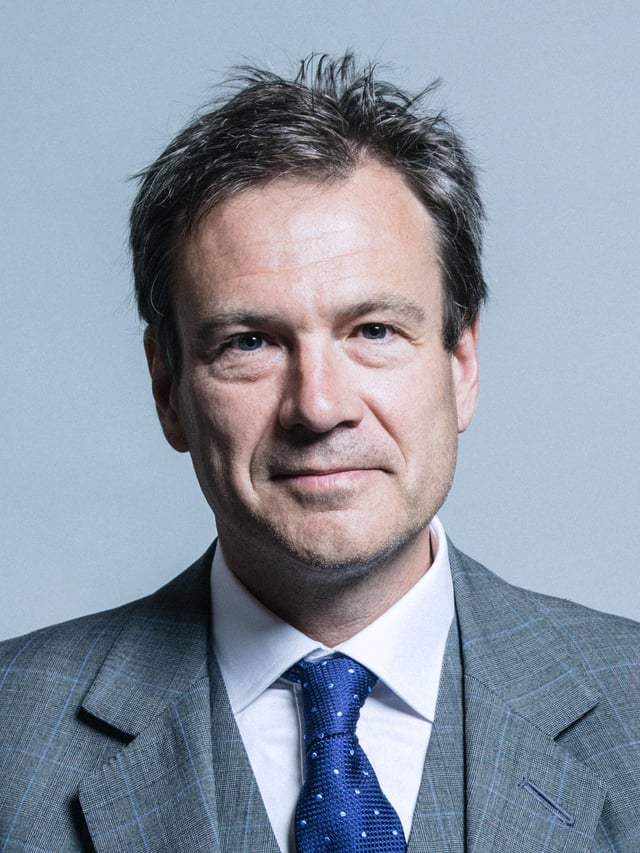
Member of Parliament for the Isle of Wight Bob Seely
The island has a single Member of Parliament. The Isle of Wight constituency covers the entire island, with 138,300 permanent residents in 2011, being one of the most populated constituencies in the United Kingdom (more than 50% above the English average).[73] In 2011 following passage of the Parliamentary Voting System and Constituencies Act, the Sixth Periodic Review of Westminster constituencies was to have changed this,[74] but this was deferred to no earlier than October 2018 by the Electoral Registration and Administration Act 2013. Thus the single constituency remained for the 2015 and 2017 general elections. However, two separate East and West constituencies are proposed for the island under the 2018 review now under way.
The Isle of Wight is a ceremonial and non-metropolitan county. Since the abolition of its two borough councils and restructuring of the county council as Isle of Wight Council in 1995, it has been a unitary authority.
Elections in the constituency have traditionally been a battle between the Conservatives and the Liberal Democrats. Andrew Turner of the Conservative Party gained the seat from Peter Brand of the Lib Dems at the 2001 general election. Since 2009, Turner was embroiled in controversy over his expenses, health, and relationships with colleagues, with local Conservatives having tried but failed to remove him in the runup to the 2015 general election.[75] He stood down prior to the 2017 snap general election, and the new Conservative Party candidate Bob Seely was elected with a majority of 21,069 votes.
At the Isle of Wight Council election of 2013, the Conservatives lost the majority which they had held since 2005 to the Island Independents, with Island Independent councillors holding 16 of the 40 seats, and a further five councillors sitting as independents outside the group.[76] The Conservatives regained control, winning 25 seats, at the 2017 local election.[6]
There have been small regionalist movements: the Vectis National Party and the Isle of Wight Party; but they have attracted little support at elections.[77]
Main towns
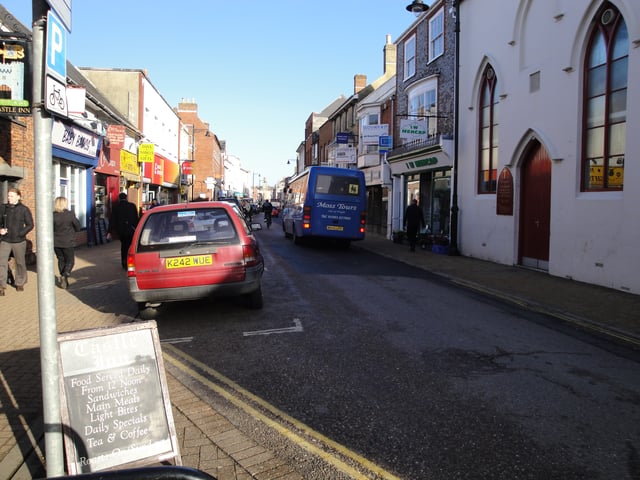
High Street in Newport, the county town
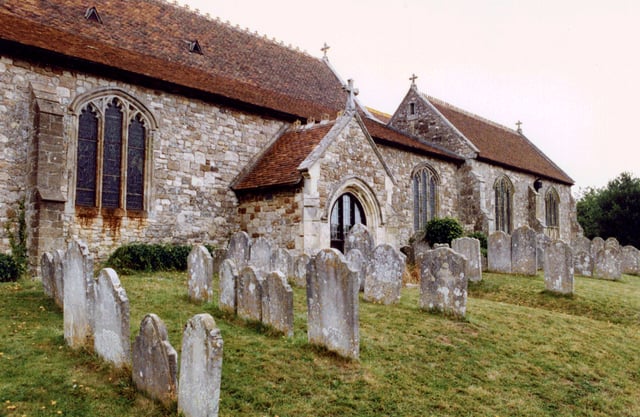
Graveyard on the grounds of the church in the town of Brading
Newport is the centrally located county town, with a population of about 25,000[78] and the island's main shopping area. Located next to the River Medina, Newport Quay was a busy port until the mid-19th century.
Ryde, the largest town with a population of about 30,000, is in the northeast. It is Victorian with the oldest seaside pier in England and miles of sandy and pebble beaches.
Cowes hosts the annual Cowes Week and is an international sailing centre.
East Cowes is famous for Osborne House, Norris Castle and as the home from 1929 to 1964 of Saunders-Roe, the historic aircraft, flying boat, rocket and hovercraft company.
Sandown is a popular seaside resort. It is home to the Isle of Wight Zoo, the Dinosaur Isle geological museum and one of the island's two 18-hole golf courses.
Shanklin, just south of Sandown, attracts tourists with its high summer sunshine levels, sandy beaches, Shanklin Chine and the old village.
Ventnor, built on the steep slopes of St Boniface Down on the south coast of the island, leads down to a picturesque bay that attracts many tourists. Ventnor Haven is a small harbour.
Culture
Language and dialect
The island has its own local and regional words. Some, such as nipper/nips (a young male person), are still commonly used and are shared with neighbouring areas of the mainland. A few are unique to the island, for example overner and caulkhead (see below). Others are more obscure and now used mainly for comic emphasis, such as mallishag (meaning "caterpillar"), gurt meaning "large", nammit (a mid-morning snack) and gallybagger ("scarecrow", and now the name of a local cheese).[81]
Identity
There remains occasional confusion between the Isle of Wight as a county and its former position within Hampshire.[82] The island was regarded and administered as a part of Hampshire until 1890, when its distinct identity was recognised with the formation of Isle of Wight County Council (see also Politics of the Isle of Wight). However, it remained a part of Hampshire until the local government reforms of 1974 when it became a full ceremonial county with its own Lord Lieutenant.[83]
In January 2009, the first general flag for the county was accepted by the Flag Institute.[84]
Island residents are sometimes referred to as "Vectensians", "Vectians" or, if born on the island, "caulkheads".[85] One theory is that this last comes from the once prevalent local industry of caulking or sealing wooden boats; the term became attached to islanders either because they were so employed, or as a derisory term for perceived unintelligent labourers from elsewhere. The term "overner" is used for island residents originating from the mainland (an abbreviated form of "overlander", which is an archaic term for "outsider" still found in parts of Australia).[86]
Residents refer to the island as "The Island", as did Jane Austen in Mansfield Park, and sometimes to the UK mainland as "North Island".[87]
To promote the island's identity and culture, the High Sheriff Robin Courage founded an Isle of Wight Day; the first was held on Saturday 24 September 2016.
Hauntings
The island is said to be the most haunted in the world, sometimes referred to as "Ghost Island". Notable claimed hauntings include God's Providence House in Newport (now a tea room), Appuldurcombe House, and the remains of Knighton Gorges.[88]
Sport
Cycling
The island is well known for its cycling, and it was included within Lonely Planet's Best in Travel Guide (2010) top ten cycling locations. The island also hosts events such as the Isle of Wight Randonnée and the Isle of Wight Cycling Festival each year. A popular cycling track is the Sunshine Trail which starts in Newport and ends in Sandown.
Rowing
There are rowing clubs at Newport, Ryde and Shanklin, all members of the Hants and Dorset rowing association.
There is a long tradition of rowing around the island dating back to the 1880s.
In May 1999 a group of local women made history by becoming the first ladies' crew to row around the island, in ten hours and twenty minutes. Rowers from Ryde Rowing Club have rowed around the island several times since 1880. The fours record was set 16 August 1995 at 7 hours 54 minutes.[89]
Two rowers from Southampton ARC (Chris Bennett and Roger Slaymaker) set the two-man record in July 2003 at 8 hours 34 minutes, and in 2005 Gus McKechnie of Coalporters Rowing Club became the first adaptive rower to row around, completing a clockwise row.[90]
The route around the island is about 60 miles (97 km) and usually rowed anticlockwise. Even in good conditions, it includes a number of significant obstacles such as the Needles and the overfalls at St Catherine's Point. The traditional start and finish were at Ryde Rowing Club; however, other starts have been chosen in recent years to give a tidal advantage.
Sailing
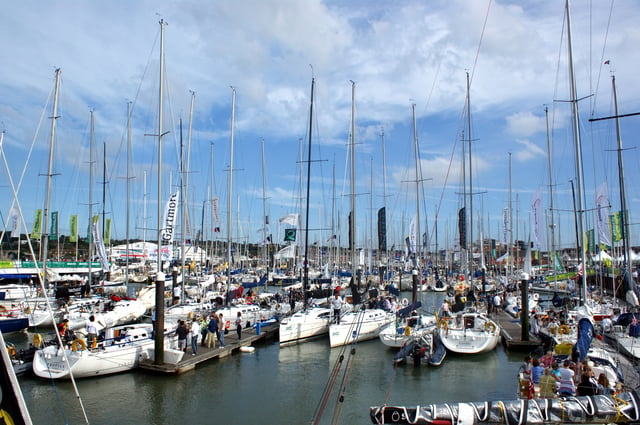
Boats in the marina during Cowes Week
Cowes is a centre for sailing, hosting several racing regattas. Cowes Week is the longest-running regular regatta in the world, with over 1,000 yachts and 8,500 competitors taking part in over 50 classes of racing.[91] In 1851 the first America's Cup race was around the island. Other major sailing events hosted in Cowes include the Fastnet race, the Round the Island Race,[92] the Admiral's Cup, and the Commodore's Cup.[93]
Trampolining
Marathon
The Isle of Wight Marathon is the United Kingdom's oldest continuously held marathon, having been run every year since 1957.[96] Since 2013 the course has started and finished in Cowes, heading out to the west of the island and passing through Gurnard, Rew Street, Porchfield, Shalfleet, Yarmouth, Afton, Willmingham, Thorley, Wellow, Shalfleet, Porchfield, and Northwood. It is an undulating course with a total climb of 1,043 feet (318 m).
Speedway
The island is home to the Wightlink Warriors speedway team, who compete in the sport's third division, the National League.
Field hockey
Following an amalgamation of local hockey clubs in 2011, the Isle of Wight Hockey Club now runs two men's senior and two ladies' senior teams. These compete at a range of levels in the Hampshire open leagues.[97]
Football
The now-disbanded Ryde Sports F.C., founded in 1888, was one of the eight founder members of the Hampshire League in 1896. There are several non-league clubs such as Newport (IW) F.C. There is an Isle of Wight Saturday Football League which feeds into the Hampshire League with two divisions and two reserve team leagues, and a rugby union club.[98][99]
Cricket

Newclose County Cricket Ground
The Isle of Wight is the 39th official county in English cricket, and the Isle of Wight Cricket Board organises a league of local clubs. Ventnor Cricket Club competes in the Southern Premier League, and has won the Second Division several times. Newclose County Cricket Ground near Newport[100][101] opened officially in 2009 but with its first match held on 6 September 2008.[102] The island has produced some notable cricketers, such as Danny Briggs, who plays county cricket for Sussex.
Island Games
The Isle of Wight competes in the biennial Island Games, which it hosted in 1993 and again in 2011.
Motor scooter
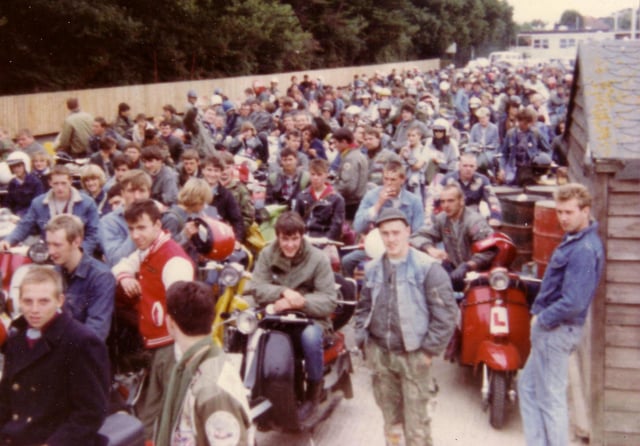
Scooterists waiting for the ferry after the Isle of Wight scooter rally in August 1983
Music
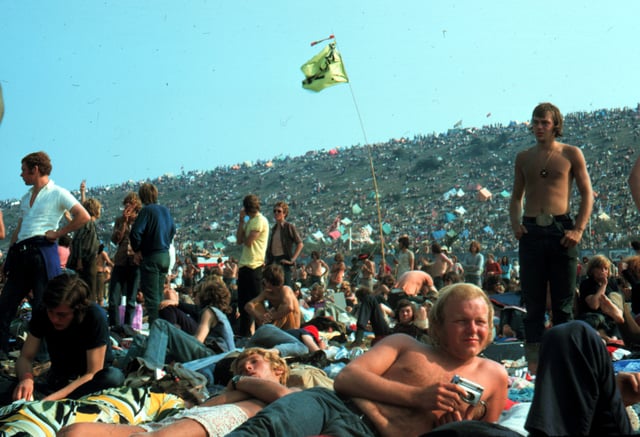
The crowd at the Isle of Wight Festival 1970 is believed to have been 600,000.
The island is home to the Isle of Wight Festival and until 2016, Bestival before it was relocated to Lulworth Estate in Dorset. In 1970, the festival was headlined by Jimi Hendrix attracting an audience of 600,000, some six times the local population at the time.[104] It is the home of the band The Bees, Trixie's Big Red Motorbike.[105]
Economy
Socio-economic data
According to the 2011 census,[112] the island's population of 138,625 lives in 61,085 households, giving an average household size of 2.27 people.
41% of households own their home outright and a further 29% own with a mortgage, so in total 70% of households are owned (compared to 68% for South East England).
Compared to South East England, the island has fewer children (19% aged 0–17 against 22% for the South East) and more elderly (24% aged 65+ against 16%), giving an average age of 44 years for an island resident compared to 40 in South East England.
Industry and agriculture
The largest industry is tourism, but the island also has a strong agricultural heritage, including sheep and dairy farming and arable crops. Traditional agricultural commodities are more difficult to market off the island because of transport costs, but local farmers have succeeded in exploiting some specialist markets, with the higher price of such products absorbing the transport costs. One of the most successful agricultural sectors is now the growing of crops under cover, particularly salad crops including tomatoes and cucumbers. The island has a warmer climate and a longer growing season than much of the United Kingdom. Garlic has been successfully grown in Newchurch for many years, and is even exported to France. This has led to the establishment of an annual Garlic Festival at Newchurch, which is one of the largest events of the local calendar. A favourable climate supports two vineyards, including one of the oldest in the British Isles at Adgestone.[113] Lavender is grown for its oil.[114] The largest agricultural sector has been dairying, but due to low milk prices and strict legislation for UK milk producers, the dairy industry has been in decline: there were nearly 150 producers in the mid-1980s, but now just 24.
Maritime industries, especially the making of sailcloth and boat building, have long been associated with the island, although this has diminished somewhat in recent years. GKN operates what began as the British Hovercraft Corporation, a subsidiary of (and known latterly as) Westland Aircraft, although they have reduced the extent of plant and workforce and sold the main site. Previously it had been the independent company Saunders-Roe, one of the island's most notable historic firms that produced many flying boats and the world's first hovercraft.[115]
Another manufacturing activity is in composite materials, used by boat-builders and the wind turbine manufacturer Vestas, which has a wind turbine blade factory and testing facilities in West Medina Mills and East Cowes.[116]
Bembridge Airfield is the home of Britten-Norman, manufacturers of the Islander and Trislander aircraft. This is shortly to become the site of the European assembly line for Cirrus light aircraft. The Norman Aeroplane Company is a smaller aircraft manufacturing company operating in Sandown. There have been three other firms that built planes on the island.[117]
Breweries
Ventnor Brewery, which closed in 2009, was the last incarnation of Burt's Brewery, brewing since the 1840s in Ventnor.[121] Until the 1960s most pubs were owned by Mews Brewery, situated in Newport near the old railway station, but it closed and the pubs were taken over by Strong's, and then by Whitbread. By some accounts Mews beer was apt to be rather cloudy and dark. In the 19th century they pioneered the use of screw top cans for export to British India.[122]
Services
Tourism and heritage
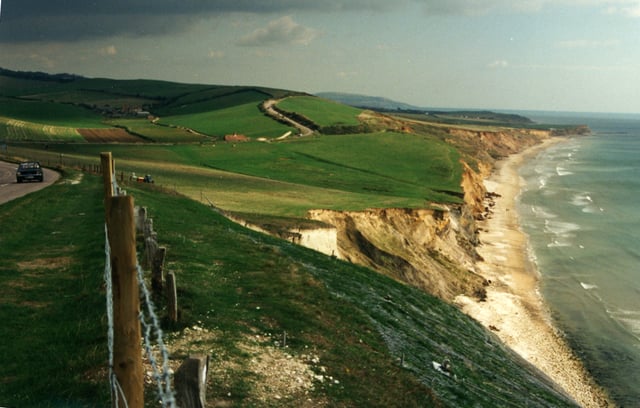
Compton Chine, looking east towards Blackgang
The island's heritage is a major asset that has for many years supported its tourist economy. Holidays focused on natural heritage, including wildlife and geology, are becoming an alternative to the traditional British seaside holiday, which went into decline in the second half of the 20th century due to the increased affordability of foreign holidays.[123] The island is still an important destination for coach tours from other parts of the United Kingdom.
Tourism is still the largest industry, and most island towns and villages offer hotels, hostels and camping sites. In 1999, it hosted 2.7 million visitors, with 1.5 million staying overnight, and 1.2 million day visits; only 150,000 of these were from abroad. Between 1993 and 2000, visits increased at an average rate of 3% per year.[124]
At the turn of the 19th century the island had ten pleasure piers, including two at Ryde and a "chain pier" at Seaview. The Victoria Pier in Cowes succeeded the earlier Royal Pier but was itself removed in 1960. The piers at Ryde, Seaview, Sandown, Shanklin and Ventnor originally served a coastal steamer service that operated from Southsea on the mainland. The piers at Seaview, Shanklin, Ventnor and Alum Bay were all destroyed by various storms during the 20th century; only the railway pier at Ryde and the piers at Sandown, Totland Bay (currently closed to the public) and Yarmouth survive.
As well as its more traditional attractions, the island is often host to walking[126] or cycling holidays through the attractive scenery. An annual walking festival[127] has attracted considerable interest. The 70 miles (113 km) Isle of Wight Coastal Path follows the coastline as far as possible, deviating onto roads where the route along the coast is impassable.[128]
A major contributor to the local economy is sailing and marine-related tourism.[129]
Summer Camp at Camp Beaumont is an attraction at the old Bembridge School site.[130]
Transport
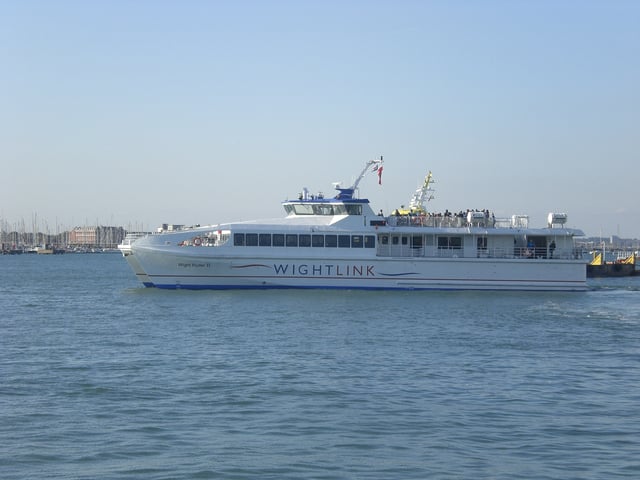
One of the Wightlink FastCats which provide a high-speed ferry service between Portsmouth and Ryde

A Southern Vectis Scania OmniDekka bus at Newport bus station
The Isle of Wight has 489 miles (787 km) of roadway. It does not have a motorway, although there is a short stretch of dual carriageway towards the north of Newport near the hospital and prison.
A comprehensive bus network operated by Southern Vectis links most settlements, with Newport as its central hub.[131]
Journeys away from the island involve a ferry journey. Car ferry and passenger catamaran services are run by Wightlink and Red Funnel, and a hovercraft passenger service (the only such remaining in the world[132]) by Hovertravel.
The island formerly had its own railway network of over 55 miles (89 km), but only one line remains in regular use. The Island Line is part of the United Kingdom's National Rail network, running a little under 9 miles (14 km) from Shanklin to Ryde Pier Head, where there is a connecting ferry service to Portsmouth Harbour station on the mainland network. The line was opened by the Isle of Wight Railway in 1864, and from 1996 to 2007 was run by the smallest train operating company on the network, Island Line Trains. It is notable for utilising old ex-London Underground rolling stock, due to the small size of its tunnels and unmodernised signalling. Branching off the Island Line at Smallbrook Junction is the heritage Isle of Wight Steam Railway, which runs for 5 1⁄2 miles (8.9 km) to the outskirts of Wootton on the former line to Newport.[133]
There are two airfields for general aviation, Isle of Wight Airport at Sandown and Bembridge Airport.
The island has over 200 miles (322 km) of cycleways, many of which can be enjoyed off-road. The principal trails are:[134]
The Sunshine Trail, which is a circular route linking Sandown, Shanklin, Godshill, and Wroxall of 12 miles (19 km);
The Troll Trail between Cowes and Sandown of 13 miles (21 km), 90% off-road;
The Round the Island Cycle Route of 62 miles (100 km).
Media
The main local newspaper is the Isle of Wight County Press, published most Fridays.
The island hosts a news website, Island Echo,[135] which was launched in May 2012.
The island has a local commercial radio station and a community radio station: commercial station Isle of Wight Radio has broadcast in the medium-wave band since 1990 and on 107.0 MHz (with three smaller transmitters on 102.0 MHz) FM since 1998, as well as streaming on the Internet.[136] Community station Vectis Radio has broadcast online since 2010, and in 2017 started broadcasting on FM 104.6. The station operates from the Riverside Centre in Newport.[137]
The island is also covered by a number of local stations on the mainland, including the BBC station BBC Radio Solent broadcast from Southampton.
Other online news sources for the Isle of Wight include On the Wight.[140]
The island has had community television stations in the past, first TV12 and then Solent TV from 2002 until its closure on 24 May 2007. iWight.tv is a local internet video news channel.
The Isle of Wight is part of the BBC South region and the ITV Meridian region.
Important broadcasting infrastructure includes Chillerton Down transmitting station with a mast that is the tallest structure on the island, and Rowridge transmitting station, which broadcasts the main television signal both locally and for most of Hampshire and parts of Dorset and West Sussex.[141]
Prisons
The Isle of Wight is near the densely populated south of England, yet separated from the mainland. This position led to it hosting three prisons: Albany, Camp Hill and Parkhurst, all located outside Newport near the main road to Cowes. Albany and Parkhurst were among the few Category A prisons in the UK until they were downgraded in the 1990s.[142] The downgrading of Parkhurst was precipitated by a major escape: three prisoners (two murderers and a blackmailer) escaped from the prison on 3 January 1995 for four days, before being recaptured.[143] Parkhurst enjoyed notoriety as one of the toughest jails in the United Kingdom, and housed many notable inmates including the Yorkshire Ripper Peter Sutcliffe, New Zealand drug lord Terry Clark and the Kray twins.
Camp Hill is located adjacent but to the west of Albany and Parkhurst, on the very edge of Parkhurst Forest, having been converted first to a borstal and later to a Category C prison. It was built on the site of an army camp (both Albany and Parkhurst were barracks); there is a small estate of tree-lined roads with the former officers' quarters (now privately owned) to the south and east. Camp Hill closed as a prison in March 2013.
The management of all three prisons was merged into a single administration, under HMP Isle of Wight in April 2009.
Education
There are 69 local education authority-maintained schools on the Isle of Wight, and two independent schools.[144] As a rural community, many of these are small and with fewer pupils than in urban areas. The Isle of Wight College is located on the outskirts of Newport.
From September 2010, there was a transition period from the three-tier system of primary, middle and high schools to the two-tier system that is usual in England.[145] Some schools have now closed, such as Chale C.E. Primary. Others have become "federated", such as Brading C.E. Primary and St Helen's Primary. Christ the King College started as two "middle schools," Trinity Middle School and Archbishop King Catholic Middle School, but has now been converted into a dual-faith secondary school and sixth form.
Since September 2011 five new secondary schools, with an age range of 11 to 18 years, replaced the island's high schools (as a part of the previous three-tier system).
Notable residents
Notable residents have included:
17th century and earlier
King Arwald, last pagan king in England
King Charles I of England, who was imprisoned at Carisbrooke Castle
Viking Earl Tostig Godwinson
Actor, highwayman and conspirator Cardell "Scum" Goodman
Soldier and regicide of Charles I Thomas Harrison, imprisoned at Carisbrooke with John Rogers & Christopher Feake
Soldier Peter de Heyno
Philosopher and polymath Robert Hooke
Murderer Michal Morey
18th century
Marine painter Thomas Buttersworth
Explorer Anthony Henday
Radical journalist John Wilkes
19th century
Queen Victoria and Prince Albert (monarch and consort), who built and lived at Osborne House
Photographer Julia Margaret Cameron, who lived at Dimbola Lodge
Irish Republican Thomas Clarke
Naval captain Jeremiah Coghlan CBG, who retired to Ryde
Writer Charles Dickens
Poet John Keats
Inventor and radio pioneer Guglielmo Marconi
Poet and hymnwriter Albert Midlane
Geologist and engineer John Milne
Regency architect John Nash
Novelist Miss Harriet Parr
Early Hong Kong Government administrator William Pedder
New Zealand PM Henry Sewell
Poet Algernon Charles Swinburne
Poet Alfred Tennyson
Philosopher Karl Marx, who stayed at 1, St. Boniface Gardens, Ventnor
Surgeon James Mann Williamson, at the Royal National Hospital, Ventnor
20th century onwards
Scriptwriter Raymond Allen
Indie rock group The Bees
Concert organist E. Power Biggs
Darts player Keegan Brown
Singer-songwriter Sarah Close
Inventor of the hovercraft Sir Christopher Cockerell
Presenter and actor Ray Cokes
Actress Bella Emberg
Yachtsman Uffa Fox
Actor Marius Goring
Survival expert and Chief Scout Bear Grylls
Actress Sheila Hancock
Folk-rock musician Robyn Hitchcock
Actor Geoffrey Hughes
Author and conspiracy theorist David Icke
Actor Jeremy Irons
Comedian Phill Jupitus
Actor Laura Michelle Kelly
Composer Albert Ketèlbey
Iranian poet Mimi Khalvati
Musician Mark King
Radio presenter Allan Lake
Musician Jack Green
Yachtswoman Ellen MacArthur
BBC 'Tonight' presenter Cliff Michelmore
Film director Anthony Minghella
Actor David Niven
Cyclist Kieran Page
TV personality Anneka Rice
Heptathlete Kelly Sotherton
Gardener and presenter Alan Titchmarsh
Novelist Edward Upward
Actor Melvyn Hayes
Places of interest
Alum Bay
Appuldurcombe House [[INLINE_IMAGE|//upload.wikimedia.org/wikipedia/commons/thumb/e/ec/EH_icon.svg/14px-EH_icon.svg.png|//upload.wikimedia.org/wikipedia/commons/thumb/e/ec/EH_icon.svg/21px-EH_icon.svg.png 1.5x, //upload.wikimedia.org/wikipedia/commons/thumb/e/ec/EH_icon.svg/28px-EH_icon.svg.png 2x|English Heritage|h14|w14]]
Amazon World Zoo
Bembridge Lifeboat Station
Blackgang Chine [[INLINE_IMAGE|//upload.wikimedia.org/wikipedia/commons/thumb/5/52/Themepark_uk_icon.png/15px-Themepark_uk_icon.png|//upload.wikimedia.org/wikipedia/commons/5/52/Themepark_uk_icon.png 1.5x|Theme Park|h19|w15]]
Brading Roman Villa [[INLINE_IMAGE|//upload.wikimedia.org/wikipedia/commons/9/9c/Museum_icon_%28red%29.png|undefined|Museum|h13|w13]]
Carisbrooke Castle [[INLINE_IMAGE|//upload.wikimedia.org/wikipedia/commons/thumb/e/ec/EH_icon.svg/14px-EH_icon.svg.png|//upload.wikimedia.org/wikipedia/commons/thumb/e/ec/EH_icon.svg/21px-EH_icon.svg.png 1.5x, //upload.wikimedia.org/wikipedia/commons/thumb/e/ec/EH_icon.svg/28px-EH_icon.svg.png 2x|English Heritage|h14|w14]] [[INLINE_IMAGE|//upload.wikimedia.org/wikipedia/commons/thumb/0/0d/CL_icon.svg/14px-CL_icon.svg.png|//upload.wikimedia.org/wikipedia/commons/thumb/0/0d/CL_icon.svg/21px-CL_icon.svg.png 1.5x, //upload.wikimedia.org/wikipedia/commons/thumb/0/0d/CL_icon.svg/28px-CL_icon.svg.png 2x|Castle|h14|w14]]
Classic Boat Museum, East Cowes [[INLINE_IMAGE|//upload.wikimedia.org/wikipedia/commons/9/9c/Museum_icon_%28red%29.png|undefined|Museum|h13|w13]]
Compton Bay
Dimbola Lodge [[INLINE_IMAGE|//upload.wikimedia.org/wikipedia/commons/9/9c/Museum_icon_%28red%29.png|undefined|Museum|h13|w13]]
Dinosaur Isle [[INLINE_IMAGE|//upload.wikimedia.org/wikipedia/commons/9/9c/Museum_icon_%28red%29.png|undefined|Museum|h13|w13]]
Fort Victoria [[INLINE_IMAGE|//upload.wikimedia.org/wikipedia/commons/e/e2/CP_icon.png|undefined|Country Park|h14|w14]]
Godshill village and model village
Isle of Wight Bus & Coach Museum [[INLINE_IMAGE|//upload.wikimedia.org/wikipedia/commons/9/9c/Museum_icon_%28red%29.png|undefined|Museum|h13|w13]]
Isle of Wight Steam Railway [[INLINE_IMAGE|//upload.wikimedia.org/wikipedia/commons/thumb/a/a9/HR_icon.svg/16px-HR_icon.svg.png|//upload.wikimedia.org/wikipedia/commons/thumb/a/a9/HR_icon.svg/24px-HR_icon.svg.png 1.5x, //upload.wikimedia.org/wikipedia/commons/thumb/a/a9/HR_icon.svg/32px-HR_icon.svg.png 2x|Heritage Railway|h13|w16]]
Isle of Wight Zoo, Yaverland [[INLINE_IMAGE|//upload.wikimedia.org/wikipedia/commons/thumb/0/0b/Zoo_icon.jpg/20px-Zoo_icon.jpg|//upload.wikimedia.org/wikipedia/commons/thumb/0/0b/Zoo_icon.jpg/30px-Zoo_icon.jpg 1.5x, //upload.wikimedia.org/wikipedia/commons/0/0b/Zoo_icon.jpg 2x|zoo|h14|w20]]
Medina Theatre
The Needles [[INLINE_IMAGE|//upload.wikimedia.org/wikipedia/commons/b/bf/NTE_icon.png|undefined|National Trust|h15|w14]]
Newport Roman Villa.
Osborne House [[INLINE_IMAGE|//upload.wikimedia.org/wikipedia/commons/thumb/e/ec/EH_icon.svg/14px-EH_icon.svg.png|//upload.wikimedia.org/wikipedia/commons/thumb/e/ec/EH_icon.svg/21px-EH_icon.svg.png 1.5x, //upload.wikimedia.org/wikipedia/commons/thumb/e/ec/EH_icon.svg/28px-EH_icon.svg.png 2x|English Heritage|h14|w14]]
Quarr Abbey [[INLINE_IMAGE|//upload.wikimedia.org/wikipedia/commons/thumb/2/2e/AP_Icon.svg/16px-AP_Icon.svg.png|//upload.wikimedia.org/wikipedia/commons/thumb/2/2e/AP_Icon.svg/24px-AP_Icon.svg.png 1.5x, //upload.wikimedia.org/wikipedia/commons/thumb/2/2e/AP_Icon.svg/32px-AP_Icon.svg.png 2x|abbey|h16|w16]]
Robin Hill [[INLINE_IMAGE|//upload.wikimedia.org/wikipedia/commons/e/e2/CP_icon.png|undefined|Country Park|h14|w14]]
Botanic Gardens, Ventnor
Yarmouth Castle [[INLINE_IMAGE|//upload.wikimedia.org/wikipedia/commons/thumb/e/ec/EH_icon.svg/14px-EH_icon.svg.png|//upload.wikimedia.org/wikipedia/commons/thumb/e/ec/EH_icon.svg/21px-EH_icon.svg.png 1.5x, //upload.wikimedia.org/wikipedia/commons/thumb/e/ec/EH_icon.svg/28px-EH_icon.svg.png 2x|English Heritage|h14|w14]] [[INLINE_IMAGE|//upload.wikimedia.org/wikipedia/commons/thumb/0/0d/CL_icon.svg/14px-CL_icon.svg.png|//upload.wikimedia.org/wikipedia/commons/thumb/0/0d/CL_icon.svg/21px-CL_icon.svg.png 1.5x, //upload.wikimedia.org/wikipedia/commons/thumb/0/0d/CL_icon.svg/28px-CL_icon.svg.png 2x|Castle|h14|w14]]
Overseas names
The Isle of Wight has given names to many parts of former colonies, most notably Isle of Wight County in Virginia founded by settlers from the island in the 17th century. Its county seat is a town named Isle of Wight.
Other notable examples include:
Isle of Wight - an island off Maryland, United States
Dunnose Head, West Falkland
Ventnor, Cowes on Philip Island, Victoria, Australia
Carisbrook, Victoria, Australia
Carisbrook, a former stadium in Dunedin, New Zealand
Ryde, New South Wales, Australia
Shanklin, Sandown, New Hampshire, United States
Ventnor City, New Jersey, United States
Gardiners Island, New York, United States shown as "Isle of Wight" on some of the older maps.[146]
Media references
Film
The film Something to Hide (1972; US title Shattered), starring Peter Finch, was filmed near Cowes, including a scene on the Red Funnel ferry;
The British film That'll Be the Day (1973), starring David Essex and Ringo Starr, included scenes shot in Ryde (notably Cross Street), Sandown (school), Shanklin (beach) and Wootton Bridge (fairground);
Mrs. Brown (1997), with Dame Judi Dench and Billy Connolly, was filmed at Osborne and Chale;
The film Fragile (2005), starring Calista Flockhart, is based on the Isle of Wight.
Victoria and Abdul (2017) starring Dame Judi Dench and Ali Fazal began shooting principal photography at Osborne House in September 2016.
Games
John Worsley's Commodore 64 game Spirit of the Stones was set on the Isle of Wight.[147]
Literature
The Isle of Wight was:[148]
the setting of Julian Barnes's novel England, England;
called The Island in some editions of Thomas Hardy's novels in his fictional Wessex;
selected for the development of a new base by the supercomputer "Colossus", in D. F. Jones' novel Colossus (1966);
the setting for D.H. Lawrence's book The Trespasser, filmed for TV on location in 1981;
the setting of Graham Masterton's book Prey;
mentioned in J.K. Rowling's first Harry Potter book, which refers to Uncle Vernon's sister Marge on holiday on the island, who got sick after eating a whelk;
a major element in Daniel O'Malley's series The Rook (2012) & its sequel Stiletto (2016). The antagonists try to invade in the 1600s, the effects of which continue to colour perceptions of the Crown's secret supernatural agency, the "Checquy Group";
the refuge of the British monarchy & government in S.M. Stirling's alternative history novel The Protector's War (2005), in which high energy technology ceased to function. After an ensuing holocaust, the island was the base for re-population of Europe, whose populations had mostly perished;
one of the destinations to which the British government evacuates in Frank Tayell's post-apocalyptic novel Surviving the Evacuation Book One: London (2013), guided by the mistaken impression that it would be defensible against the zombie hordes;[149]
featured in John Wyndham's novel The Day of the Triffids and Simon Clark's sequel The Night of the Triffids.
Music
The Beatles' song "When I'm Sixty-Four" (1967), credited to Lennon-McCartney and sung by Paul McCartney, refers to renting a cottage on the island;[150]
Bob Dylan recorded "Like a Rolling Stone" (1965), "Minstrel Boy", "Quinn the Eskimo (The Mighty Quinn)" (1967), and "She Belongs to Me" (1965) for the album Self Portrait (1970) live on the island;
"Wight Is Wight" (1969), a song by French artist Michel Delpech, also spawned an Italian cover by Dik Dik, titled "L'isola di Wight"(IT) (1970).
Radio
There was a running joke in radio sitcom The Navy Lark involving Sub-Lieutenant Phillips's inability to navigate and subsequently tail the Isle of Wight ferry.[151]
Television
ITV's dramatisation of Dennis Potter's work Blade on the Feather (19 October 1980) was filmed on the island.[152]
The 1984 TV mini series , Annika, was partly filmed in Ryde.
A 2002 Top Gear feature showed an Aston Martin being driven around Cowes, East Cowes, and along the Military Road and seawall at Freshwater Bay.[153]
The setting for Free Rein was based on the Isle of Wight.[154]
See also
List of civil parishes on the Isle of Wight
List of places on the Isle of Wight
List of current places of worship on the Isle of Wight
List of High Sheriffs of the Isle of Wight
List of Lord Lieutenants of the Isle of Wight
List of Governors of the Isle of Wight
List of hills of the Isle of Wight
Isle of Wight gasification facility
Isle of Wight NHS Trust
Isle of Wight Rifles
Yaverland Battery
